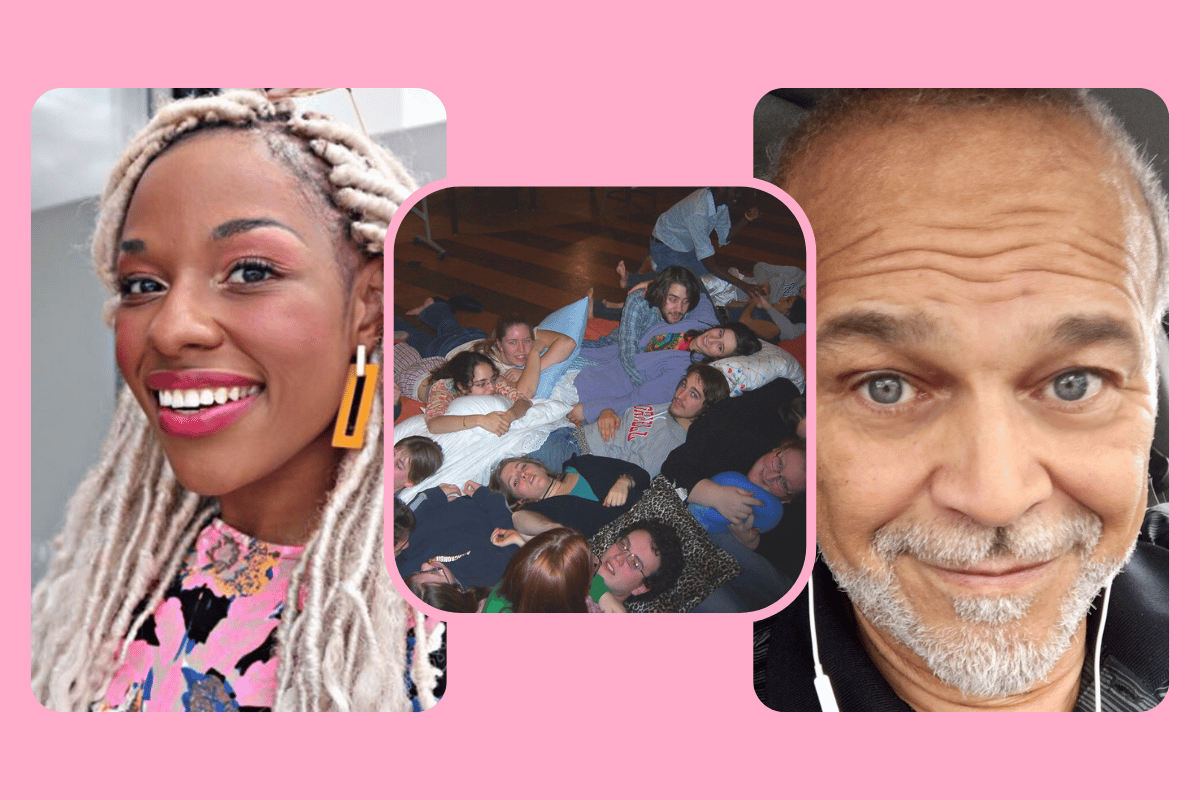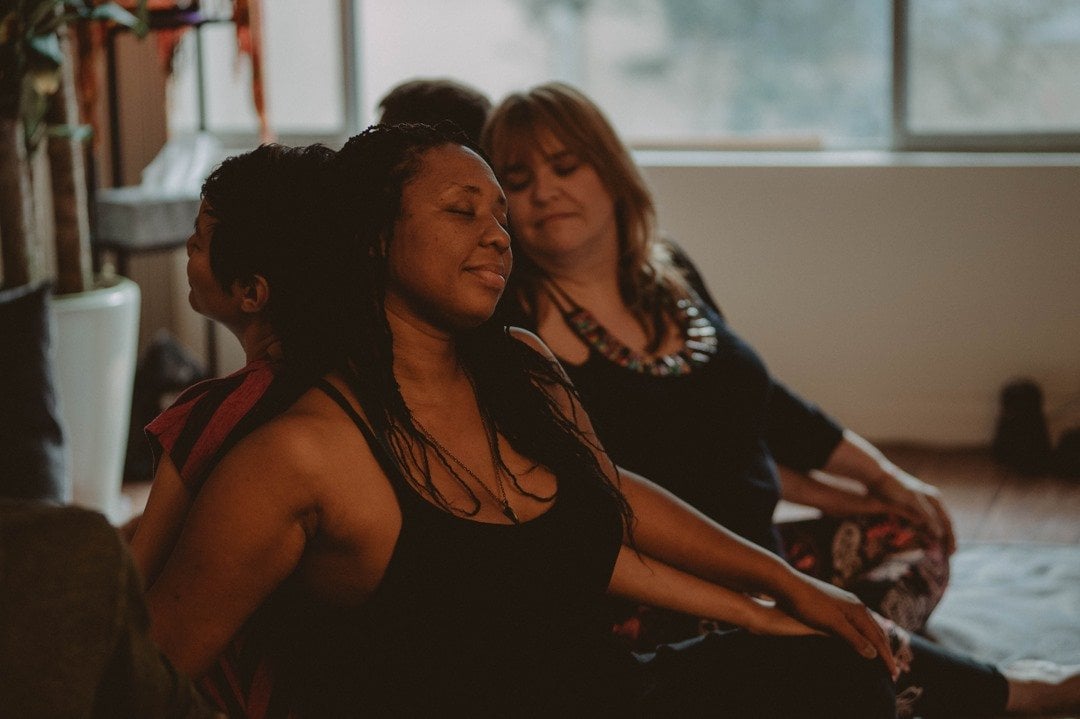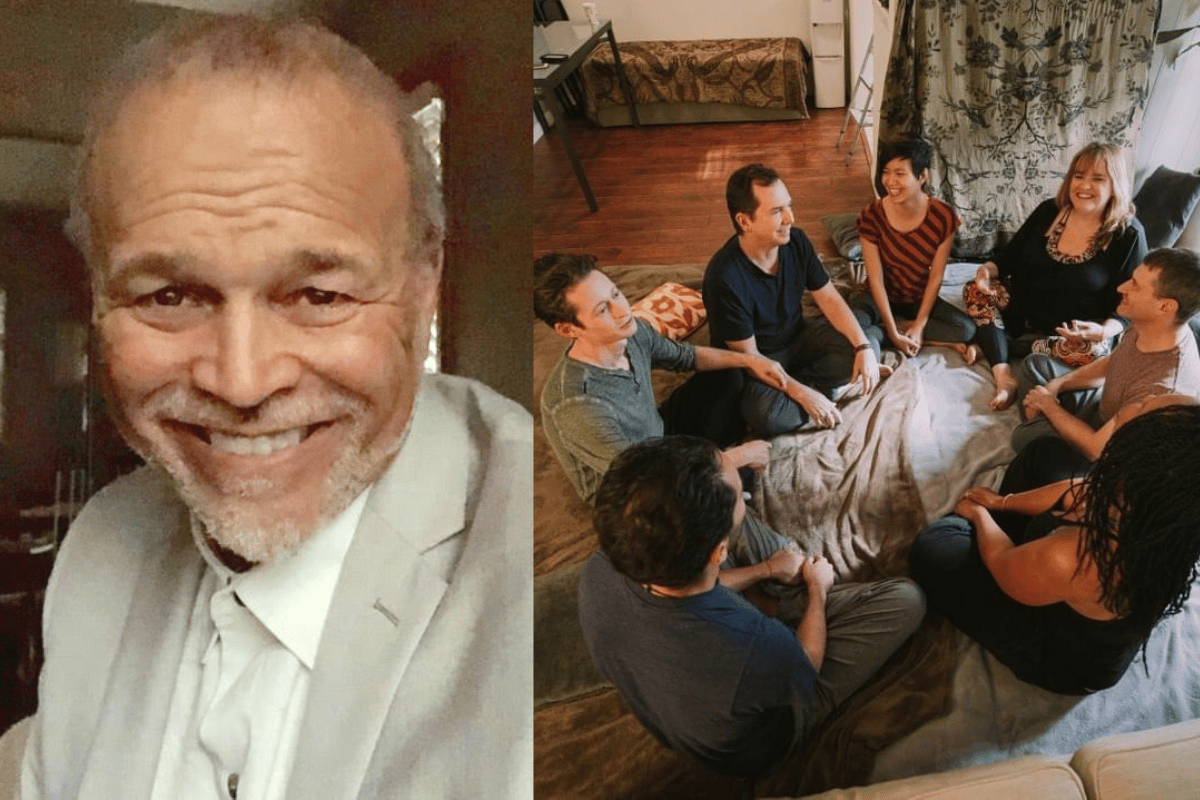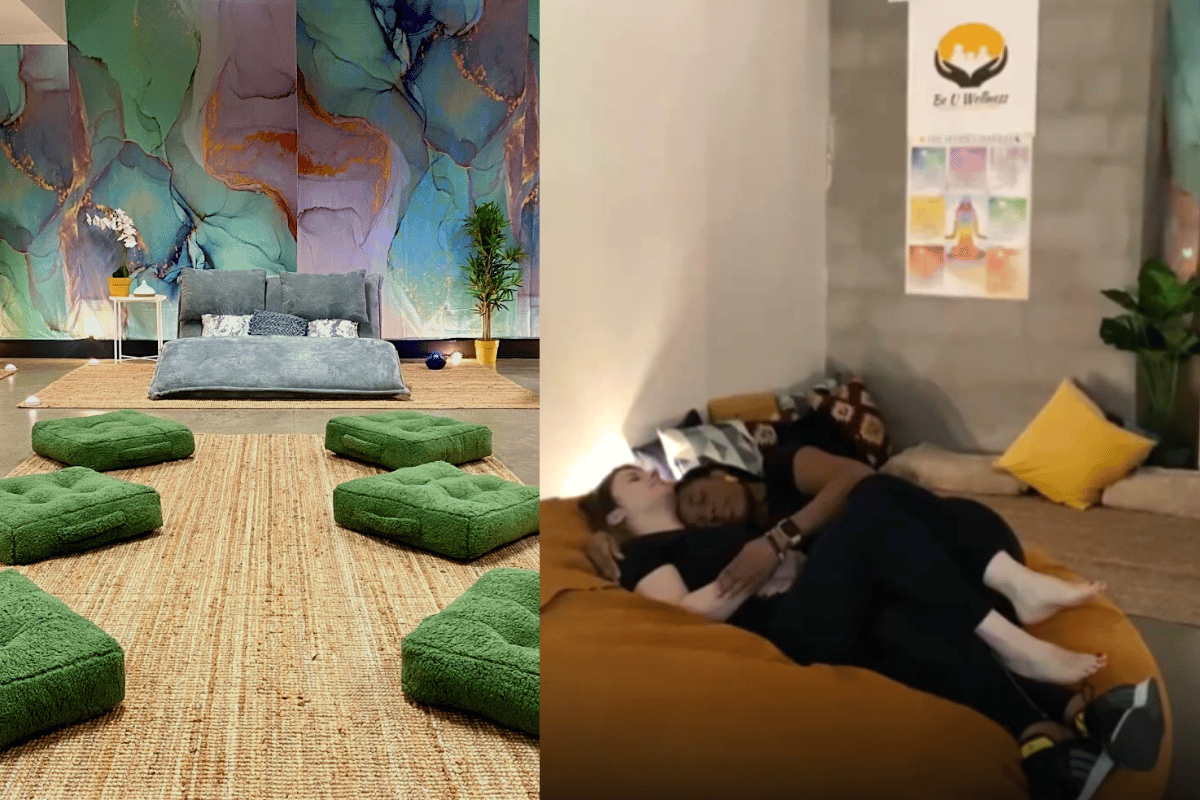
When Bob Long went to his first cuddle party seven years ago, nothing could have prepared him for what he was about to take part in.
It was at the cuddle party facilitator's apartment – a nice, clean space filled with two dozen or so people running from the ages of around 30 to 50, all sitting together in a huddle.
They were in the living room, which was filled with foam cushions, assorted pillows, cartoonish stuffed animals and blankets spread across the floor. Soft chit-chat and background music could be heard as the dozens of adults began to embrace one another on the floor – limbs on limbs, heads resting on other people's chests, deep breaths and an unnerving sense of serenity.
Unlike what the mind immediately jumps to, this party didn't involve sex or romance. Instead, it was – and always is – purely platonic.
But perhaps there is nothing more intimate than embracing a complete stranger in a room full of faces you don't recognise.
***
Bob had heard about cuddle parties through the grapevine – a friend in the tantric yoga world recommending he give it a go. Based on her recommendation, he found a local cuddle party event via the internet and signed up.
"I tried to be alert, aware and present. People were nice and seemed pleased to meet me. It felt weird. I felt weird," Bob reflected to Mamamia.
"The closer it got the more nervous I became. What will happen? Is this sexual? How will I respond or react? Will I be the oldest person there and considered 'icky?' Will anyone be willing to interact with me? Will it be all people who already know each other, and I'll be the outsider?"
After that first cuddle party experience, it took Bob some time to venture back to another event.
But for a while, Bob worked as a photographer taking images of the parties for PR purposes, as per a request from a facilitator. It was in his comfort zone – he was now an observer rather than a participant.
 Image: Cuddle Party Inc. Facebook.
Image: Cuddle Party Inc. Facebook.
It was through this work that Bob started to ease into the "vibe, the people and the process" of cuddle parties. So he joined once again.
In that first year of attending cuddle parties, Bob mostly went by himself, before then beginning to invite friends who had expressed curiosity.
"Most of my loved ones had no interest or felt scared, nervous, unsure – for reasons they had difficulty explaining. One friend called it more of my 'hippie stuff' left over from our youth in the late '60s and early '70s. I never pushed it."
Then two years after just being the attendee, Bob learned how to facilitate – and now at the age of 72, he hasn't looked back.
"Being responsible for and of service to others keeps me on my toes. There was an interest in having a balance of masculine and feminine energies (a yin-yang balance) involved in facilitating. That sounded good to me," he said to Mamamia.
He loves being able to provide purposeful support and knowing how to balance each attendee's comfort levels, to ensure it is a positive experience.
"I believe in the mission and message behind cuddle parties – the power of non-sexual, platonic, nurturing, supportive and intimate touch."
For Bob, his cuddle parties in Chicago, Illinois, go for four hours and cost attendees $20 to $25 USD per event. 20 to 25 people is considered a good number, hopefully with a mix of new and experienced cuddlers. It's enough people to fill a space, not make too much noise and disturb the neighbours, while also allowing the facilitator to keep an eye on everyone and how the event is progressing.
Gender balance is also a priority for Bob, although he notes that it "proved a bit tough as gender doesn't necessarily define identity".
For Bob's parties specifically, and in the Chicago area, the demographic of cuddlers are fairly wide-ranging – mostly white, a few Black and Asian participants, mostly heterosexual but with some LGBTQIA+ representation too.
And for ages, it often ranges from late 20s to mid-60s – mostly from a white collar or middle-class background and quite progressive too.
"Although commercial rooms, small halls or rented spaces can work, homes and apartments have an intimacy, a sense of being lived in that is good. I like a room of size to be able to keep everyone in sight, but have enough room for people to find a sense of semi-privacy, intimacy and solitude if they wished, and to have room to stretch. It's about the energy as well," Bob explained.
 Bob Long and an American cuddle party. Image: Supplied/Cuddle Party Inc. Facebook.
Bob Long and an American cuddle party. Image: Supplied/Cuddle Party Inc. Facebook.
But there are very strict and established boundaries – something all Cuddle Party Inc. associated events stand by. And the topic of consent is greatly discussed before, during and after an event, Bob said.
"Even the word and concept 'platonic' needs to be explained and defined for the event."
There is a 'rules, regulations, and expectations talk', called 'The Opening Circle,' before the cuddle party begins, which goes for around 45 minutes. These 11 rules lay out the do's and don'ts and the mission of the Cuddle Party. It talks heavily about setting one's boundaries, making clearly worded requests, giving and receiving permission, consent and learning how to say 'no' and to hear 'no.' There are also practice exercises during this time.
As Bob said: "It is a powerful opening, setting the stage for a safe and fun event that often yields personal growth too."
The doors to the event are then closed at a set time, so no one else can enter the space who hasn't listened to the Opening Circle discussion.
Then the cuddling begins.
For Bob, he has seen firsthand the power of engaging in a cuddle party.
"While the act and process of cuddling – and learning how to cuddle – may have therapeutic outcomes for some, for me cuddle parties are simply a gathering to engage in a primordial activity. It's human-to-human touching that satisfies a deep need, desire or innate feeling in us as humans."
As he said: "Good touches, being held, supported, nurtured, simply feels good – period. One needn't only be in a traumatic state or come from a place of trauma for cuddling to be desirable, pleasing, fun and rewarding in my opinion."
In the seven years since his first cuddle party, Bob has learned that anything to do with human touch and intimacy – even when not sexual in nature – often brings about an immediate judgement from others.
"Some were aghast saying, 'Whaaat! Oh no, sounds weird. I couldn't do that!' Some were neutral, others were intrigued, and a few were deeply interested. But, in general, I don't tend to talk about it – know your audience, that kind of thing."
Bob doesn't call what he does 'cuddle therapy', as he is not a trained or licensed therapist of any kind. He leaves that title up to the pros.
Pros just like Tariro.
For over two years now she has been working as a cuddle therapist from her own commercial space in Sydney, seeing clients one on one.
She first became interested in the world of cuddling in 2016 when she was diagnosed with multiple sclerosis – finding comfort through the holistic wellness space. She was also in the midst of a divorce, and with two young kids, it was a stressful time. But she knew there were others out there struggling too. And she wanted to help.
"I started off by giving out my phone number to people telling them they could always call me if they were mentally not coping. I felt like there was an empty void that needed to be filled. I then started looking into cuddle therapists for myself, and when I saw how little options there were, I realised I could do it myself," Tariro said to Mamamia.
She trained and registered with Cuddle Therapy Australia and began her hugging journey.
Some people pay Tariro to have their hair stroked. Others like their feet touched gently. And many love to be embraced and held tightly. And the demographic of Tariro's clients is incredibly varied – her youngest client being 18, and her oldest an 82-year-old woman.
 Tariro's work space and her cuddling a client (who has given permission for the image to be reshared). Image: Supplied/Instagram @beuwellnesssydney.
Tariro's work space and her cuddling a client (who has given permission for the image to be reshared). Image: Supplied/Instagram @beuwellnesssydney.
Originally, Tariro was working out of her home, but soon found a commercial space was the right environment for a cuddle therapy session. When you walk into her studio everything is spaced out beautifully – soft furnishings, bean bags, blankets and lounges all around. Nothing is too loud or bold – designed to immediately put someone at ease as soon as they walk in.
And with some low lighting levels, and essential oils in the air, Tariro is ready to work with her next client.
"All my sessions typically are an hour and start from $150. With her own disability to take into account, Tariro typically sees one or two clients per day during the working week.
But for her, cuddle therapy doesn't really feel like 'work'. It's her passion.
"Human touch is so powerful. It can offer the same neurological reaction as taking painkillers – it's this research and the emotional benefits of human touch that explains why people volunteer to hold premature babies at hospitals. Because safely cuddling and touching the babies, while in a sterile environment, has a majorly positive effect on the child's development. Like with skin-on-skin between a mother and her baby," Tariro explained.
"A lot of people think that as we become adults, we don't need to be touched anymore. But platonic touch therapy is something we all need."
Originally from Zimbabwe, Tariro said her African family were initially very concerned when she told them about the work she was doing, likely not understanding the platonic nature of a cuddle session. But now they really admire that "I've nurtured my true passion. And my kids love what I do as well".
Just like boundary conversations are key at cuddle parties, the same thing goes for Tariro too.
"It's therapeutic healing and relaxation – we never touch private areas or go underneath someone's clothes. It's purely platonic and I'm a therapist – there's no sex or sexual touching involved."
For a cuddle therapist, it does often involve working with clients impacted by trauma – and over the years of working in the field, Tariro has seen the benefits cuddle therapy can bring.
"I have clients where the first two to three sessions involve us sitting at opposite ends of the room because they've got a trauma they're working through. And by the end of the 10-week program, we'll be sitting next to one another or I'll be able to touch their back – and that's a success," she said.
"For these people directly affected by trauma and trying to work through it, I wouldn't recommend going to a cuddle party. That's a different setting than the one they require. But the overall joy of cuddle therapy is that we strip away all the vulnerabilities and are left with connection, comfort and relaxation."
Ultimately, both Tariro and Bob think more of us shouldn't be afraid of hugging a consenting stranger.
As Bob said, from birth babies blossom as soon as they are nurtured, touched and held. So to continue this through to adulthood can be really nourishing for the soul.
"Going to cuddle parties continued my growth and development as a man caught up in the swirling change of gender, sexual, cultural, racial and other structured roles. It helps me to continue my ability to learn how to relate to my partner and loved ones, as well as being gentler and more nurturing to myself and others," Bob told Mamamia.
"Being cuddled and cuddling others is its own wonderful, intimate thing. So too is exploring consent and boundaries. And as a bonus, cuddles with others have the potential to provide a more delicious and conscious everyday life beyond the cuddle room."
For more from Tariro, you can follow her business' Instagram, or you can visit her business website Be U Wellness Sydney which has more information.
The quotes given by Bob Long are his own views and not specific to Cuddle Party Inc.
Feature Image: Supplied/Facebook.

